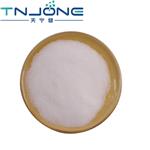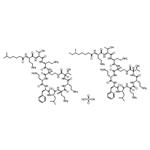- Polymyxin B sulfate
-

- $0.00 / 1kg
-
2024-04-12
- CAS:1405-20-5
- Min. Order: 1kg
- Purity: 99%
- Supply Ability: 1000kg
- Polymyxin B Sulphate
-

- $0.00 / 25Kg/Bag
-
2024-04-10
- CAS:1405-20-5
- Min. Order: 2Kg/Bag
- Purity: 6500IU/mg, USP
- Supply Ability: 20 tons
- Polymyxin B sulfate
-

- $5.00 / 1KG
-
2024-04-08
- CAS:1405-20-5
- Min. Order: 1KG
- Purity: 98%
- Supply Ability: g-kg-tons, free sample is available
|
| | Polymyxin B sulfate Chemical Properties |
| Melting point | 217-220°C (dec.) | | storage temp. | 2-8°C | | solubility | H2O: 50 mg/mL | | form | powder | | pka | pKa 8.9 (Uncertain) | | color | colorless or slightly yellow | | PH | pH (10g/L, 25℃) : 4.5~7.0 | | optical activity | [α]/D 20/D (Rotation: -2.3 +/- 0.2 degrees) | | Water Solubility | Soluble in water at 50mg/ml/n | | Merck | 14,7573 | | Stability: | Hygroscopic | | InChIKey | HFMDLUQUEXNBOP-UHFFFAOYSA-N | | LogP | -6.361 (est) | | CAS DataBase Reference | 1405-20-5(CAS DataBase Reference) | | EPA Substance Registry System | Polymixin B sulfate (1405-20-5) |
| Hazard Codes | Xn | | Risk Statements | 22 | | Safety Statements | 22-24/25 | | RIDADR | 3249 | | WGK Germany | 3 | | RTECS | TR1150000 | | F | 3-8-10 | | HS Code | 2941 90 00 | | HazardClass | 6.1(b) | | PackingGroup | III | | Toxicity | dog,LDLo,intracrebral,320ug/kg (0.32mg/kg),BEHAVIORAL: COMA,British Journal of Pharmacology and Chemotherapy. Vol. 23, Pg. 552, 1964. |
| | Polymyxin B sulfate Usage And Synthesis |
| Indications | Polymyxin B sulfate is similar with polymyxin E, and has either bacteriostatic or bactericidal effect on various kinds of gram-negative bacteria, such as Escherichia coli, Pseudomonas aeruginosa, Escherichia coli deputy, Klebsiella pneumoniae, acidophilus, Bordetella pertussis and Shigella dysentery. It is mainly applied to the treatment of infection in wounds, the urinary tract, eyes, ears, and bronchus caused by Pseudomonas aeruginosa and other kinds of pseudomonas. It can also be applied for treating sepsis, peritonitis, and severe infection caused by aminoglycoside-resistant, third generation cephalosporins-resistant bacteria and Pseudomonas aeruginosa or other sensitive strains, such as bacteremia, endocarditis, pneumonia, and burn infection.
| | Dosage | 1. Intravenous injection: Adults and children with normal renal function: 1.5 to 2.5 mg per kilogram of body weight per day (for per kg body weight, generally apply not more than 2.5 mg), divide into 2 times with 1 time every 12 hours of infusion. Dilute every 50mg of the product with 500 mL of 5% glucose solution and further add drop wise. Babies with normal renal function can tolerate a amount of 4 mg/day per kilogram of body weight.
2. Intramuscular injection: Adults and children: apply 2.5 to 3 mg per kilogram of body weight; apply in divided doses with applying 1 time every 4 to 6 hours. For baby, the dosage can be 4 mg per day per kilogram of body weight. For new born children, we can apply to 4.5 mg per time per kilogram of body weight.
3. intrathecal injection (for Pseudomonas aeruginosa meningitis): Each mL of drug solution prepared by the sodium chloride injection contains 5mg. Adults and children with over 2 years of age, apply 5 mg daily; after application of 3 to 4 days, change one time every other day, and continue for at least 2 weeks until the result of cerebrospinal fluid culture becomes negative and the sugar inspection becomes normal. For children less than 2 years of age, apply 2mg 1 time per day for continuous 3 to 4 days (or 2.5mg per every other day); after that, apply 2.5mg every other day, until the test becomes normal.
4. The ophthalmic solution concentration: 1~2.5mg per milliliter.
| | Drug Interactions | We should avoid apply it in combination with drugs causing significant damage to the kidneys, skeletal muscle relaxants, aminoglycoside antibiotics, and anesthetic drugs with significant effect of muscle relaxation (such as enflurane). Also we should avoid simultaneous intravenous administration of quinine, and magnesium. Combining polymyxin B sulfate with sulfa drugs, rifampicin, and semi-synthetic penicillin has a better efficacy than single application in treating severe infections resistant Gram-negative bacteria.
The above information is edited by the chemicalbook of Dai Xiongfeng.
| | Injection polymyxin B sulfate manufacturer | Shanghai “Xin Xianfeng” Pharmaceutical Co., Ltd. Zhunzi H31022973
Shanghai No. 1 Biochemical Pharmaceutical Co., Ltd. Zhunzi H31022631
| | Precautions | 1. Pregnant and lactating women, children, patients with severe kidneys damage and severe kidney dysfunction should either take with caution or reduce the administrated amount.
2. this product has relative large toxicity and a poor efficacy in treating deep tissue infection. It is also not the primary choice of drug for treating any kinds of infection.
3. intravenous injection may lead to respiratory depression and thus should generally not used. Half of the amount in daily dose should subject to intravenous drip, and can’t subject to disposable rapid bolus avoid extensive neuromuscular blockade.
4. it shouldn’t be used in combination with drugs with other renal toxicity or neuromuscular blocking effects to avoid accidents.
| | Uses | Biochemical studies.
Polymyxin B is a kind of anti-Gram-negative poly-peptide antibiotics which can alter membrane structure allowing small molecules leakage and inhibit the growth of Gram-negative bacteria. It has bactericidal effect on Escherichia coli through binding to the lipid A portion of bacterial lipopolysaccharide. Mechanism of action: bind and interfere with the permeability o the cellular membrane. Anti-bacteria spectrum: gram negative bacteria.
| | Description | The polymyxins are cationic peptides originally isolated from B. polymyxa. They bind and kill Gram-negative bacteria. The B series of polymyxins consist of a cyclic heptapeptide and a tripeptide side chain acylated at the amino terminus by a fatty acid. Polymyxin B (sulfate) is a mixture of at least four closely related components, polymyxin B1 to B4, with polymyxin B1 and B2 being the two major components. Polymyxin B (sulfate) has rapid in vitro bactericidal activity against major multidrug-resistant Gram-negative bacteria, such as P. aeruginosa, A. baumannii, and K. pneumoniae. | | Chemical Properties | White Solid | | Uses | Polymyxin B sulfate is used as topical antibiotic agent, often used in combination with neomycin; products include ointments, creams, eye, and ear drops. | | Uses | antibacterial | | Uses | Antibiotic with bactericidal action on E. coli. Binds to the lipid A portion of bacterial lipopolysaccharides. Induces pore formation in the membranes of cortex cells from excised sorghum roots. Mixtu
re of Polymyxin B1 and B2 sulfate.
Biological potency (dry basis): >6000U/mg. | | Indications | Polymyxin B is one of a group of cyclic polypeptides elaborated by
Bacillus polymyxa. The drug is a surface-active agent. It is thought to alter the
lipoprotein membrane of bacteria so that it no longer functions as an effective
barrier, thereby allowing the cell contents to escape. Polymyxin B is effective against
Pseudomonas, E. coli, and other gram-negative bacteria except the Proteus and
Serratia species. It has little effect on gram-positive organisms. | | Brand name | (GlaxoSmithKline); Poly-Rx (X Gen). | | General Description | Polymyxin (Aerosporin) was discovered in 1947 almost simultaneouslyin three separate laboratories in the UnitedStates and Great Britain. As often happens whensimilar discoveries are made in widely separated laboratories,differences in nomenclature, referring to both theantibiotic-producing organism and the antibiotic itself, appearedin references to the polymyxins. Because the organismsfirst designated as Bacillus polymyxa and B.aerosporus Greer were found to be identical species, thename B. polymyxa is used to refer to all of the strains thatproduce the closely related polypeptides called polymyxins.Other organisms (e.g., see “Colistin” later) also producepolymyxins. Identified so far are polymyxins A, B1,B2, C, D1, D2, M, colistin A (polymyxin E1), colistin B(polymyxin E2), circulins A and B, and polypeptin. Theknown structures of this group and their properties havebeen reviewed by Vogler and Studer. Of these,polymyxin B as the sulfate usually is used in medicine because,when used systemically, it causes less kidney damagethan the others. Polymyxin B sulfate is a nearly odorless, white to buff powder. It is freely soluble in water and slightly soluble in alcohol. | | Biochem/physiol Actions | Polymyxin B?is one of the most important antibiotics used to treat gram-negative bacterial infections, including infections caused by carbapenem-resistant non-fermenters and carbapenem-resistant?Enterobacteriaceae. | | Clinical Use | Polymyxin B is produced by fermentation of Bacillus polymyxa. It is separated from a mixture of related
cyclic peptides and is primarily active against Gram-negative microorganisms. It apparently binds to
phosphate groups in bacterial cytoplasmic membranes and disrupts their integrity. It is used IM or IV as a
sulfate salt to treat serious urinary tract infections, meningitis, and septicemia, primarily caused by
Pseudomonas aeruginosa, but some other Gram-negative bacteria also will respond. Irrigation of the urinary
bladder with solutions of polymyxin B sulfate is employed as well by some to reduce the incidence of
infections subsequent to installation of indwelling catheters. Additionally, it is used ophthalmically to treat
infections by P. aeruginosa. When given parenterally, the drug is neuro- and nephrotoxic and, therefore, is
employed only after other drugs have failed. | | in vitro | polymyxin b elicited up-regulation of dendritic cells (dcs) maturation markers, including the increase in the in the expression of co-stimulatory molecule cd86 and hla-class i and ii molecules. polymyxin b induced a progressive increase in the adhesion property of human dcs. in addition, polymyxin b triggered the activation of the erk1/2 pathway and iκb-α/nf-κb pathways [1]. | | in vivo | male bacteraemia ddy mice were subcutaneously treated with polymyxin b at a dose of 5, 10, 15 or 20 mg/kg for 7 days. polymyxin b, in a dose-dependent fashion, improved the survival both of ou-01062- and ou-98039-infected mice. in polymyxin b-treated mice, except for 5 mg/kg polymyxin b, the viable cell counts had a tendency to reduce steadily in each concentration group. it was showed a rapid and marked decline of bacterial cell count between 3 to 6 h after infection [2]. | | storage | Room temperature | | references | [1]. valentinis, b., bianchi, a., zhou, d., cipponi, a., catalanotti, f., russo, v., & traversari, c. direct effects of polymyxin b on human dendritic cells maturation: the role of i b- /nf- b and erk1/2 pathways and adhesion. journal of biological chemistry. 2005; 280(14): 14264-14271.
[2]. miyajima, y., hiramatsu, k., mizukami, e., morinaga, r., ishii, h., & shirai, r. et al. in vitro and in vivo potency of polymyxin b against imp-type metallo-β-lactamase-producing pseudomonas aeruginosa. international journal of antimicrobial agents. 2008; 32(5): 437-440. |
| | Polymyxin B sulfate Preparation Products And Raw materials |
|